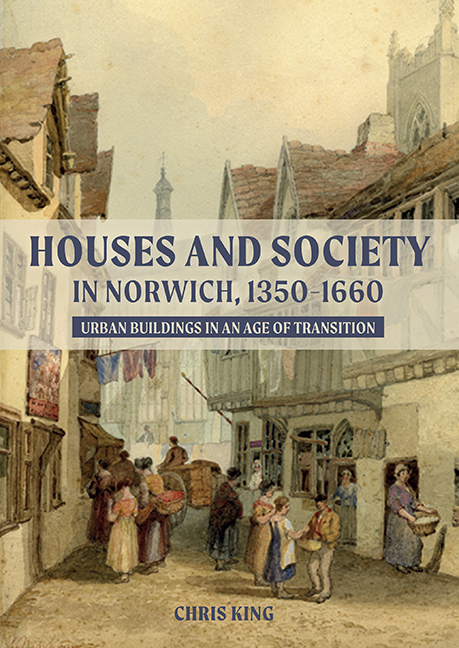Book contents
- Frontmatter
- Dedication
- Contents
- List of plates and figures
- List of tables
- Acknowledgements
- List of Abbreviations
- 1 Urban rebuildings, urban transitions
- 2 Norwich, 1350–1660: continuity and change in an English provincial city
- 3 Medieval merchants’ houses, c.1350–1540
- 4 Early modern merchants’ houses, c.1540–1660
- 5 The urban elite: domestic space, social identity and civic authority
- 6 Medieval houses and the urban ‘great rebuilding’
- 7 Houses of the ‘middling sort’: buildings and the use of space
- 8 Housing the urban poor and immigrant communities
- Conclusions
- Glossary
- Bibliography
- Index
- Plate Section
7 - Houses of the ‘middling sort’: buildings and the use of space
Published online by Cambridge University Press: 23 October 2020
- Frontmatter
- Dedication
- Contents
- List of plates and figures
- List of tables
- Acknowledgements
- List of Abbreviations
- 1 Urban rebuildings, urban transitions
- 2 Norwich, 1350–1660: continuity and change in an English provincial city
- 3 Medieval merchants’ houses, c.1350–1540
- 4 Early modern merchants’ houses, c.1540–1660
- 5 The urban elite: domestic space, social identity and civic authority
- 6 Medieval houses and the urban ‘great rebuilding’
- 7 Houses of the ‘middling sort’: buildings and the use of space
- 8 Housing the urban poor and immigrant communities
- Conclusions
- Glossary
- Bibliography
- Index
- Plate Section
Summary
THIS chapter moves forward in time to consider in more depth the architectural and archaeological evidence for houses in the post-medieval period following the impact of the great fires of 1507 and the subsequent rebuilding, broadly covering the period between the mid-sixteenth and later seventeenth centuries. This takes in the majority of the surviving pre-1700 houses in the city, and the chapter provides a description of the building materials, mode of construction and plan form and layout of these buildings. Several of the trends identified in the preceding chapter, including the shift towards more substantial and fireproof building materials, the move towards fully two-storeyed houses and the increasing use of upper floors, continue to develop across the later sixteenth and seventeenth centuries. Excavated evidence remains an important complement to the architectural evidence, enabling us to gain a picture of the urban dwelling as a dynamic productive space. Domestic spaces were integrated with spaces for industry, retail and storage, while beyond the principal dwelling urban tenements were built up with workshops, sheds and yards and contained features such as hearths, ovens, furnaces, wells and drains, which were essential to a wide variety of craft activities and the broader functioning of the urban household.
This chapter is largely concerned with the more substantial examples of early modern domestic buildings, with generally between two or three rooms on each floor, often arranged with a street-front range and a rear range, which may have been built at a separate time. They are likely, therefore, to represent the houses of more prosperous traders and artisans who formed the core of the early modern ‘middling sort’. As will be argued, these houses fit well with the probate inventory evidence for Norwich first analysed by Priestley and Corfield (1982), which also broadly encompasses the same social spectrum. These documentary sources are placed alongside the building evidence in the second half of the chapter to consider questions of house size and the use of domestic space within this broadly defined urban group. The smallest houses in the city, which tend to be of single-cell plan, are considered in Chapter 8, which reviews the architectural and archaeological evidence for smaller houses, tenements and the housing of the urban poor and migrant communities.
- Type
- Chapter
- Information
- Houses and Society in Norwich, 1350–1660Urban Buildings in an Age of Transition, pp. 215 - 242Publisher: Boydell & BrewerPrint publication year: 2020



